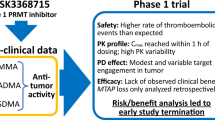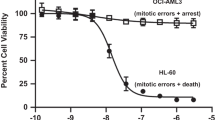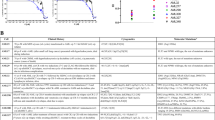Abstract
Farnesyl transferase inhibitors (FTIs) target signal-transduction pathways responsible for the proliferation and survival of hematologic malignancies, including acute myelogenous leukemias (AML). Lonafarnib has been shown to be a potent inhibitor of Pgp-mediated drug efflux. On the basis of these findings, we examined the Pgp-inhibitory properties of tipifarnib and assessed its activity when combined with anthracyclines. The effects of tipifarnib on cell proliferation, induction of apoptosis and inhibition of Pgp-mediated anthracycline efflux were analyzed in two human leukemia cell lines overexpressing Pgp (CCRF-CEM and KG1a). Measurement of residual daunorubicin (DNR)-mediated fluorescence after incubation with DNR and tipifarnib demonstrated that tipifarnib significantly inhibited DNR efflux in CCRF-CEM with an IC50 value less than 0.5 μ M. Proliferation and apoptosis assays after exposure to DNR in the presence or absence of tipifarnib demonstrated synergistic inhibition of cellular proliferation, and induction of apoptosis with the combination of tipifarnib and DNR. Similar data was obtained with an enantiomer of tipifarnib that possesses no FTI activity. Incubation with tipifarnib and DNR did not interfere with inhibition of the post-translational processing of HDJ-2. These data suggest that tipifarnib possesses Pgp-inhibitory activity in addition to its FTI activity. In high risk and refractory patients these properties may be exploited as a dual targeting mechanism in the therapy of AML.
This is a preview of subscription content, access via your institution
Access options
Subscribe to this journal
Receive 12 print issues and online access
$259.00 per year
only $21.58 per issue
Buy this article
- Purchase on Springer Link
- Instant access to full article PDF
Prices may be subject to local taxes which are calculated during checkout






Similar content being viewed by others
References
Cortes JE, Kurzrock R, Kantarjian HM . Future clinical implications for farnesyl transferase inhibitors in hematologic malignancies. Semin Hematol 2003; 39: 26–30.
Hiddemann W, Kern W, Schoch, Fonatsch C, Heinecke A, Wormann B et al. Management of acute myeloid leukemia in elderly patients. J Clin Oncol 1999; 17: 3569–3576.
Baer MR, George SL, Dodge RK, O'Loughlin KL, Minderman H, Caligiuri MA et al. Phase 3 study of the multidrug resistance modulator PSC-833 in previously untreated patients 60 years of age and older with acute myeloid leukemia: Cancer and Leukemia Group B Study 9720. Blood 2002; 100: 1224–1232.
Leith C, Kopecky KJ, Godwin J . Acute myeloid leukemia in the elderly: assessment of multidrug resistance (MDR1) and cytogenetics distinguishes biologic subgroups with remarkably distinct responses to standard chemotherapy. A southwest oncology group study. Blood 1997; 189: 3323–3329.
Dastugue N, Payen C, Lafage-Pochitaloff M, Bernard P, Leroux D, Huguet-Rigal F et al. Prognostic significance of kayrotype in de novo adult acute myeloid leukemia. Leukemia 1995; 9: 1491–1498.
Rebollo A, Martrinez-A C . RAS proteins: recent advances and new functions. Blood 1999; 94: 2971–2980.
Cox AD, Der CJ . Farnesyltransferase inhibitors and cancer treatment: targeting simply RAS? Biochem Biophys Acta 1997; 1333: F51–F71.
Sepp-Lorenzino L, Ma Z, Rands E . A peptidomimetic inhibitor of farnesyl:protein transferase blocks the anchorage-dependent and-independent growth of human tumor cell lines. Cancer Res 1995; 55: 5302–5309.
Lebowitz PF, Prendergast GC . Non-Ras targets of farnesyltransferase inhibitors: focus on Rho. Oncogene 1998; 17: 1439–1445.
Johnston SRD . Farnesyl transferase inhibitors: a novel targeted therapy for cancer. Lancet 2001; 2: 18–26.
Jiang K, Coppola D, Crespo NC . The phosphoinositide 3-OH kinase/AKT2 pathway as a critical target for farnesyltransferase inhibitor-induced apoptosis. Mol Cel Biol 2000; 20:139–148.
Wang E, Casciano CN, Clement RP, Johnson WW . The farnesyl protein transferase inhibitor SCH66336 is a potent inhibitor of the MDR1 product p-glycoprotein. Cancer Res 2001; 61: 7525–7529.
Wang E-J, Casciano CN, Clement RP, Johnson WW . In vitro flow cytometry method to quantitatively assess inhibitors of P-glycoprotein. Drug Metab Disp 2000; 28: 522–528.
Chou TC, Talalay P . Quantitative analysis of dose-effect relationships: the combined effects of multiple drugs or enzyme inhibitors. Adv Enzyme Regul 1984; 22: 27–55.
Estaquier J, Tanaka M, Suda T, Nagata S, Golstein P, Ameisen JC . Fas-mediated apoptosis of CD4+ and CD8+ T cells from human immunodeficiency virus-infected persons: differential in vitro preventive effect of cytokines and protease antagonists. Blood 1996; 87: 4959–4966.
Neckers L, Mimnaugh E, Schulte TW . The Hsp90 chaperone family. In: Latchman DS (eds.), Stress Proteins. Springer-Verlag, New York, 1999, 9–42.
Britten CD, Rowinsky EK, Soignet S . A phase I and pharmacological study of the farnesyl protein transferase inhibitor L-778,123 in patients with solid malignancies. Clin Cancer Res 2001; 7: 3894–3903.
Karp JE, Lancet JE, Kaufmann SH . . Blood 2001; 97: 3361–3369.
Adjei AA, Davis JN, Ehrlichman C, Svingen PA, Kaufman SH . Comparison of potential markers of farnesyltransferase inhibition. Clin Cancer Res 2000; 6: 2318–2325.
Rowinsky EK, Windle JJ, Von Hoff DD . Ras protein farnesyltransferase: a strategic target for anticancer therapeutic development. J Clin Oncol 1999; 17: 3631–3652.
End DW . Farnesyl protein transferase inhibitors and other therapies targeting RAS signal transduction pathway. Invest New Drugs 1999; 17: 241–258.
Ghauharali RI, Westerhoff HV, Dekker H, Lankelma J . Saturable P-glycoprotein kinetics assayed by fluorescence studies of drug efflux from suspended human KB8-5 cells. Biochem Biophys Acta 1996; 1278: 213–222.
Punt CJ, van Maanen L, Bol CJ, Seifert WF, Wagener DJ . Phase I and pharmacokinetic study of the orally administered farnesyl transferase inhibitor R115777 in patients with advanced solid tumors. Anticancer Drugs 2001; 12: 193–197.
Wang G, Pincheira R, Zhang JT . Dissection of drug-binding-induced conformation changes in P-glycoprotein. Eur J Biochem 1998; 255: 388–390.
Wang RB, Kuo CL, Lien LL, Lien EJ . Structure-activity relationship: analyses of p-glycoprotein substrates and inhibitors. J Clin Pharm Ther 2003; 28: 203–228.
Wang EJ, Lew K, Casciano CN, Clement RP, Johnson WW . Interaction of common azole antifungals with P-glycoprotein. Antimicrob Agents Chemother 2000; 46: 160–165.
Liesveld JL, Lancet JE, Rosell KE . Effects of the farnesyl transferase inhibitor R115777 on normal and leukemic hematopoiesis. Leukemia 2003; 17: 1806–1812.
Caponigro F . Farnesyl transferase inhibitors: a major breakthrough in anticancer therapy? Naples, 12 April 2002. Anticancer Drugs 2002; 13: 891–897.
Kokenberg E, Sonneveld P, Delwel R, Sizoo W, Hagenbeek A, Lowenberg B . In vivo uptake of daunorubicin by acute myeloid leukemia (AML) cells measured by flow cytometry. Leukemia 1998; 2: 511–517.
Marie JP, Faussat-Suberville AM, Zhou D, Zittoun R . Daunorubicin uptake by leukemic cells: correlations with treatment outcome and mdr1 expression. Leukemia 1993; 7: 825–831.
Persons DL, Yazlovitskaya EM, Cui W, Pelling JC . Cisplatin-induced activation of mitogen-activated protein kinases in ovarian carcinoma cells: inhibition of extracellular signal-regulated kinase activity increases sensitivity to cisplatin. Clin Cancer Res 1999; 5: 1007–1014.
Yeh PY, Chuang SE, Yeh KH, Song YC, Chang LL, Cheng AL . Phosphorylation of p53 on Thr55 by ERK2 is necessary for doxorubicin-induced p53 activation and cell death. Oncogene 2004; 23: 3580–3588.
Acknowledgements
NIH Grants CA106349, CA099176 and CA079446 to SGE.
Author information
Authors and Affiliations
Corresponding author
Rights and permissions
About this article
Cite this article
Medeiros, B., Landau, H., Morrow, M. et al. The farnesyl transferase inhibitor, tipifarnib, is a potent inhibitor of the MDR1 gene product, P-glycoprotein, and demonstrates significant cytotoxic synergism against human leukemia cell lines. Leukemia 21, 739–746 (2007). https://doi.org/10.1038/sj.leu.2404539
Received:
Revised:
Accepted:
Published:
Issue Date:
DOI: https://doi.org/10.1038/sj.leu.2404539
Keywords
This article is cited by
-
Clinicopathological and molecular features of myeloid sarcoma as initial presentation of therapy-related myeloid neoplasms: a single institution experience
International Journal of Hematology (2014)
-
Combined p21-activated kinase and farnesyltransferase inhibitor treatment exhibits enhanced anti-proliferative activity on melanoma, colon and lung cancer cell lines
Molecular Cancer (2013)
-
Molecular and cytogenetic changes in multi-drug resistant cancer cells and their influence on new compounds testing
Cancer Chemotherapy and Pharmacology (2013)
-
Targeting of CD34+CD38-cells using Gemtuzumab ozogamicin (Mylotarg) in combination with tipifarnib (Zarnestra) in acute Myeloid Leukaemia
BMC Cancer (2012)
-
A yeast-based genomic strategy highlights the cell protein networks altered by FTase inhibitor peptidomimetics
Molecular Cancer (2010)



